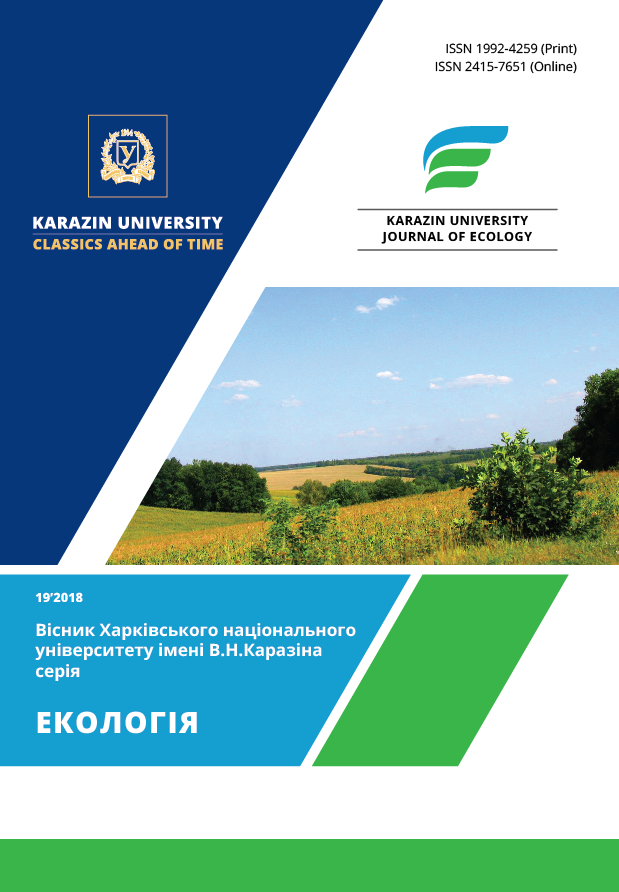Mesozooplankton study in Odessa bay in 2016-2017
Abstract
Purpose. Study of the current state of mesozooplankton in Odessa Bay coastal waters, 2016-2017. Methods. Standard methods of sampling, determination of mesozooplankton species composition, number and biomass. Results. Mesozooplankton sampled every 10 days and monthly in the area of the University Hydrobiological Station has been studied, taxonomic composition, number and biomass of each species determined; the results have been analysed and presented. Mesozooplankton biodiversity indices have been assessed in the coastal waters. Seasonal changes in number and biomass of the main mesozooplankton groups have been studied. Two zooplankton sampling methods have been compared. Marine environment quality has been assessed using the metrics of mesozooplankton. Altogether 31 and 22 taxa belonging to 9 main mesozooplankton groups have been identified in 2016 and 2017 respectively. The dominant groups were Copepoda, Rotatoria, Protozoa, Cladocera and Harpacticoida. Mesozooplankton number and biomass in 2016-2017 varied within broad limits from 600 ind./m³ and 0.24 mg/m³ (10.03.2017) to 225920 ind./m³ (10.06.2017) and 5471.96 mg/m³ (29.06.2017). Significant differences in the values of mesozooplankton number and biomass were revealed through sampling at the stations with different depth, which can be explained by both spatial inhomogeneity and different vertical distribution of those characteristics due to the features of the vertical distribution of temperature and salinity with depth. It was established that in shallow areas sampling with Juday net was more effective and representative than sampling with modified Apstein net. Analysis of marine environmental quality assessments using three different metrics of mesozooplankton has shown that the method of quality assessment using biomass was the most representative. Conclusions. Marine environment quality was assessed mainly as «Bad» and «Very Bad» for 82% of samples, «Good» and «High» for 4%, «Moderate» for 14% of samples. The performed assessment proves unsatisfactory conditions for mesozooplankton community normal development and functioning in Odessa Bay coastal waters.
Downloads
References
Gruzov, L.N., Lyumkis, P.V., Napadovskiy, G.V. (1994). Issledovaniya prostranstvenno-vremennoy struktury planktonnykh polei severnoy poloviny Chernogo morya v 1002-1993 gg. [Study of planktonic fields’ spatial & temporal structure in the Black Sea northern half in 1992-1993]. Black Sea Ecosystem Study. Odessa, 94-113. (In Russian)
Zaitsev, Yu.P., Aleksandrov, B.G., Minicheva, G.G. et al. (2006). Severo-zapadnaya chast Chernogo morya: biologiya i ekologiya [North-western Black Sea; biology and ecology]. Kiev: Nukova Dumka,701. (In Russian)
Kiselev, I.A. (1956). Metody issledovaniya lanktona [Plankton studying methods]. In: Life of the USSR fresh waters. L.: Publisher of the USSR Academy of Sciences, 4 (1), 183-265. (In Russian)
Vorobyova, L.V., Kulakova, I.I., Sinegub, I.A. et al., (2017). Odesskiy region Chernogo morya: gidrobiologiya pelagiali I bentali [Odessa Region of the Black Sea: hydrobiology of pelagic and benthic zones]. Odessa, Astroprint, 324. (In Russian)
Aleksandrov, B., Arashkevich, E., Gubanova, A., Korshenko, A. (2014). Black Sea monitoring guidelines: mesozooplankton. Publ. EMBLAS Project, BSC, 31.
Moncheva, S., Boicenco, L. (2014). State of Environment Report of the Western Black Sea based on Joint MISIS cruise. – MISIS Joint Cruise Scientific Report, 401.
Stefanova, К., Stefanova, E., Doncheva, V. (2016). A classification system for evaluation of ecological status of coastal marine waters in respect of zooplankton biological element of quality. Proceeding of «Seminar of ecology – 2015 with international participation», Sofia, Bulgaria, 231-240.
Project UNDP- EU «Improving Environmental Monitoring in the Black Sea, Phase 2 - EMBLAS-II» (2015-2018). Available at: http://www.emblasproject.org
Opredelitel fauny Chernogo I Azovskogo morey (1961). [Identification guide of the Azov and Black Seas fauna]. Kiev: Naukova Dumka, 1, 437. (In Russian)
Opredelitel fauny Chernogo I Azovskogo morey (1969). [Identification guide of the Azov and Black Seas fauna]. Kiev: Naukova Dumka, 2, 536. (In Russian)
Kozhova, O.M., Melnik, N.G. (1978). Instruktsiya po obrabotke prob planktona schetnym metodom [Instruction on plankton samples processing using counting method]. Irkutsk. 3-18. (In Russian)
Kovalova, N.V., Medinets, V.I., Mileva, A.P., Botnar, M.G., Snigirov, S.M., Gazyetov, Ye.I. Medinets, S.V. (2017). Porivnyalna otsinka yakosti pryberezhnykh morskikh vod Odeskoyi zatoky I rayonu ostrovu Zmiinyi v 2016 [Comparative assessment of quality of marine coastal waters of Odessa bay and the Zmiinyi Island area in 2016]. Visnyk of V.N.Karazin Kharkiv National University Series Ecology, (16), 132-140. (In Ukrainian)
Berlinskiy, N.A., Popov, Yu.I. (2018). Formirovanie pridonnoy gipoksii I serovodorods na shelfe Chernogo morya [Forming of near-bottom hypoxia and hydrogen sulphide on the Black Sea shelf]. Visnyk of V.N.Karazin Kharkiv National University Series Ecology, (18), 6-13. (In Russian)
Authors who publish with this journal agree to the following terms:
- Authors retain copyright and grant the journal right of first publication of this work under the terms of a license Creative Commons Attribution License 4.0 International (CC BY 4.0).
- Authors are able to enter into separate, additional contractual arrangements for the non-exclusive distribution of the journal's published version of the work (e.g., post it to an institutional repository or publish it in a book), with an acknowledgement of its initial publication in this journal.
- Authors are permitted and encouraged to post their work online (e.g., in institutional repositories or on their website) prior to and during the submission process, as it can lead to productive exchanges, as well as earlier and greater citation of published work.





